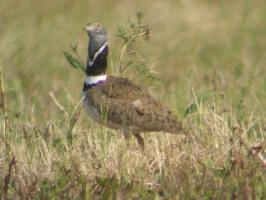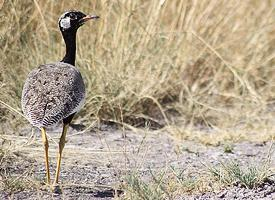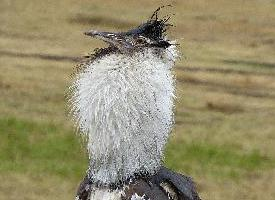
Description de l'animal
The Little Bustard (Tetrax tetrax) is a fascinating bird species belonging to the bustard family, known for its distinctive appearance and intriguing behaviors. This medium-sized bird is adept at blending into its natural habitats, thanks to its cryptic plumage that mirrors the earthy tones of the grasslands and agricultural fields it prefers. The species exhibits a notable sexual dimorphism, with males and females sporting significantly different looks, especially during the breeding season.Males are particularly striking with their robust size, reaching up to 45 centimeters in length and displaying a remarkable black and white neck pattern. This contrast is most vivid during the mating season, when males puff out their white throats in an impressive display to attract females. Their upper parts are a mottled brown, providing excellent camouflage against the ground, while the underparts are primarily white. Females and juveniles, on the other hand, are more subdued in coloration, with their plumage blending seamlessly into their surroundings, making them harder to spot.
The Little Bustard is a ground-dwelling bird, preferring open landscapes such as grasslands, steppes, and agricultural fields where it can forage for its diet mainly consisting of seeds and insects. Its preference for seeds makes it particularly fond of areas with a mix of natural and cultivated vegetation. The bird's diet diversifies with the availability of food sources, occasionally including small vertebrates and plant matter.
One of the most remarkable aspects of the Little Bustard's behavior is its breeding display. The male performs a visually and audibly striking courtship dance, which includes a series of jumps, wing flappings, and a unique, deep, foghorn-like call that can be heard from a considerable distance. This display serves not only to attract females but also to assert dominance and territory over rival males.
The Little Bustard is a migratory bird, with populations in the colder regions moving southwards to spend the winter in warmer climates. This migration is crucial for their survival, allowing them to escape the harsh winter conditions and access more abundant food sources.
Conservation status of the Little Bustard is of increasing concern, as its habitat faces significant threats from agricultural intensification, land development, and habitat fragmentation. These pressures have led to a decline in their populations across much of their range, making conservation efforts vital for their survival. Efforts to preserve their habitats, along with sustainable farming practices, are crucial to ensure the continued existence of this unique species.
In summary, the Little Bustard is a captivating bird species, whose life cycle and behaviors are intricately linked to the open landscapes it inhabits. Its survival is a testament to the delicate balance of ecosystems and highlights the importance of conservation efforts to protect these environments and their avian inhabitants.
Animaux similaires
Nouvelles photos d'animaux
Top 10 des animaux
- Dolphin gull (Leucophaeus scoresbii)
- Diana monkey (Cercopithecus diana)
- Moustached guenon (Cercopithecus cephus)
- Galápagos tortoise (Geochelone nigra complex)
- Russian tortoise (Testudo horsfieldii)
- Japanese macaque (Macaca fuscata)
- Stone loach (Barbatula barbatula)
- Greek tortoise (Testudo graeca)
- Common flying dragon (Draco volans)
- Colossal squid (Mesonychoteuthis hamiltoni)


